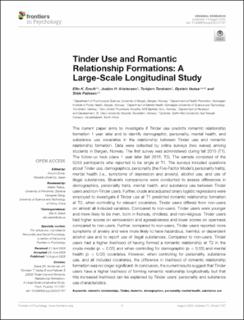| dc.description.abstract | The current paper aims to investigate if Tinder use predicts romantic relationship formation 1 year later and to identify demographic, personality, mental health, and substance use covariates in the relationship between Tinder use and romantic relationship formation. Data were collected by online surveys (two waves) among students in Bergen, Norway. The first survey was administered during fall 2015 (T1). The follow-up took place 1 year later (fall 2016, T2). The sample consisted of the 5253 participants who reported to be single at T1. The surveys included questions about Tinder use, demographics, personality (the Five-Factor Model’s personality traits), mental health (i.e., symptoms of depression and anxiety), alcohol use, and use of illegal substances. Bivariate comparisons were conducted to assess differences in demographics, personality traits, mental health, and substance use between Tinder users and non-Tinder users. Further, crude and adjusted binary logistic regressions were employed to investigate if Tinder use at T1 predicted romantic relationship formation at T2, when controlling for relevant covariates. Tinder users differed from non-users on almost all included variables. Compared to non-users, Tinder users were younger and more likely to be men, born in Norway, childless, and non-religious. Tinder users had higher scores on extroversion and agreeableness and lower scores on openness compared to non-users. Further, compared to non-users, Tinder users reported more symptoms of anxiety and were more likely to have hazardous, harmful, or dependent alcohol use and to report use of illegal substances. Compared to non-users, Tinder users had a higher likelihood of having formed a romantic relationship at T2 in the crude model (p < 0.05) and when controlling for demographic (p < 0.05) and mental health (p < 0.05) covariates. However, when controlling for personality, substance use, and all included covariates, the difference in likelihood of romantic relationship formation was no longer significant. In conclusion, the current results suggest that Tinder users have a higher likelihood of forming romantic relationship longitudinally, but that this increased likelihood can be explained by Tinder users’ personality and substance use characteristics | en_US |
| dc.description.localcode | Copyright © 2020 Erevik, Kristensen, Torsheim, Vedaa and Pallesen. This is an open-access article distributed under the terms of the Creative Commons Attribution License (CC BY). The use, distribution or reproduction in other forums is permitted, provided the original author(s) and the copyright owner(s) are credited and that the original publication in this journal is cited, in accordance with accepted academic practice. No use, distribution or reproduction is permitted which does not comply with these terms. | en_US |

